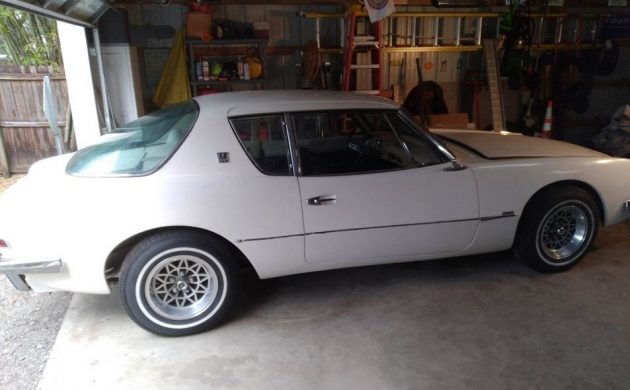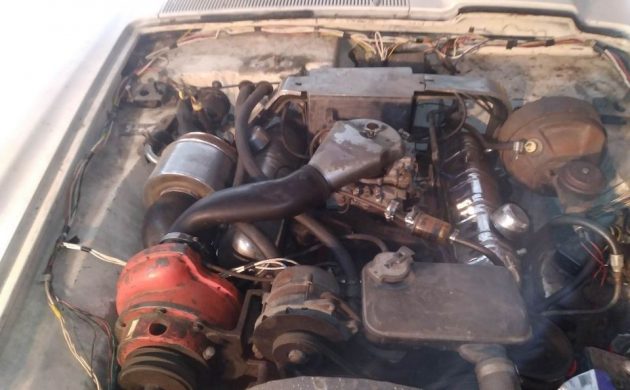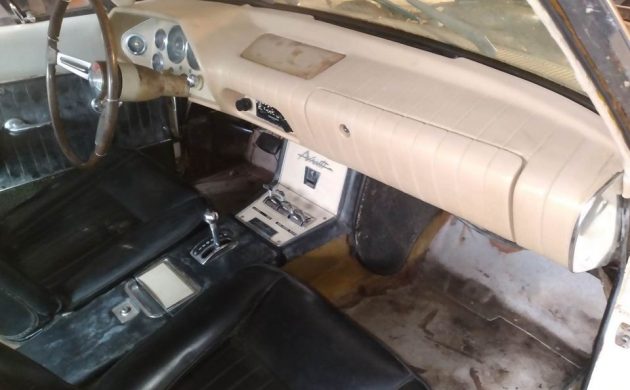R2 Supercharger! 1963 Studebaker Avanti
If you ask most any Studebaker aficionado what car their Holy Grail is, chances are that person would say the limited run Avanti with the supercharged engine. Only 4,643 Avanti’s were built for 1963-64 with 40 percent of those being the R2 (289 V8 with the booster). The car combined luxury with performance, as the R2 version output one horsepower per cubic inch. The seller of this ’63 Avanti describes it as a true barn find, but garage find might be more appropriate. Located in Wesley Chapel, Florida it needs some attention and is available here on Facebook Marketplace for $18,000.
The Studebaker Avanti went from a doodle on a cocktail napkin to a prototype car in less than a year. And went into production by the middle of 1962 for the ’63 model year. Because Studebaker wasn’t on a solid financial footing at the time, some short-cuts were necessary. One was the use of fiberglass body panels and the other the recycling of existing drivetrain components. Which would make both good decisions, especially the 289 cubic inch motor that dated back to the 1950s and wouldn’t be the first time Studebaker included a supercharger to get maximum punch out of a car. In this case, the Paxton centrifugal supercharger did the job.
Studebaker brass was hoping to build and sell 20,000 of the cars a year, but early delays in production quickly lowered expectations. Only 2,810 of the R1 (non-supercharged) Avanti’s were built and 1,833 more with the supercharger were assembled before production at Studebaker’s South Bend, Indiana plan ceased around Christmas 1963 and remaining operations shifted to Canada. The Avanti did not make that trip, so sales of the car barely made it into calendar 1964.
The Avanti would be saved by a couple of Studebaker dealers who bought the name and engineering, and the automobile would see limited production until into the 21st Century. They continued using fiberglass bodywork, but the mechanical components would be largely Chevrolet-based, like using 327 and 350 V8 engines. From the car’s limited original run, the seller offers a ’63 R2 edition with 113,000 miles on the odometer. While it has the high-powered version of the engine, it has an automatic transmission instead of the somewhat more desirable 4-speed.
This is a two-owner car that the seller says is in good overall condition but doesn’t mention if the car actually runs and how capable the supercharger is. The body, chrome and glass look good, but the paint has some nicks here and there and could be a repaint. The Avanti may have been sitting for a while as the interior looks dirty and the carpeting has been removed, whether in anticipation of replacement or the need to attend to the floorboards. The controls in the console for the heater and defroster have an interesting set of levers I had not noticed before on an Avanti. The license plate on the back shows the car was last registered in 1985.
Hagerty pegs a ’63 Avanti in Fair condition at $11,500 in terms of resale value, and $19,700 if in Good condition. This car may lie somewhere between the two levels and the R2 hardware will likely add more to that than the original $210 premium it cost buyers back in ’63. I’ve always been a fan of underdog cars and the Avanti would surely qualify as one. It would make my Holy Grail list.
Auctions Ending Soon
 2006 Jeep Wrangler SportBid Now1 days$11,750
2006 Jeep Wrangler SportBid Now1 days$11,750
 1974 Datsun 260ZBid Now3 days$750
1974 Datsun 260ZBid Now3 days$750
 2010 Proterra Ecoliner PrototypeBid Now3 days$200
2010 Proterra Ecoliner PrototypeBid Now3 days$200
 1960 Austin Healey SpriteBid Now6 days$500
1960 Austin Healey SpriteBid Now6 days$500
 1976 Cadillac Coupe DeVilleBid Now6 days$1,000
1976 Cadillac Coupe DeVilleBid Now6 days$1,000







Comments
Always been somewhat conflicted with Avanti’s, though I think the design is aging very well. Tend to like the squared headlights, but there is a black series one in my neighborhood, and in person it is absolutely stunning. Would like a convertible if I had my pick
Wasn’t aware that Avanti had a convertible in the stable.
A much later addition – maybe the 80’s – was the convertible.
An all time favorite. I almost bought one in Palatka Florida in 2007. Looked just like this one!
Those temp controls are standard for a 63 & 64.
Lived in a apartment above a Studebaker Dealer when these came out. Loved them ever since.
Looking at the engine bay pictures, there are no belts on the supercharger and also missing some fittings on top. That make me a little concerned. I guess the Paxton can be rebuilt but it won’t be cheap
Nice car but ten to one it doesn’t run. Supercharger has no belts, unless I’m missing something, which probably means there are other issues as well.
No belts on the Supercharger oh no…
What is a R2 worth when restored?
Read the article…
There were no Studebaker Avanti Convertibles.
Steve Blake built 3 Avanti II convertibles (between 1983 and1985?) with Chevy 305cid HO engines.
J.J. Caffero built many 1987+ convertibles, however, they were on Caprice frames and suffer visually.
Avanti’s soldiered on with more variants after Caffero and Im sure some were convertibles.
The ’85 Blake Avanti IIs were the best IMHO. Rare and pricey if you can find one for sale.
A “Creamsicle” orange and white Avanti R2 sold within the last couple of years for approx $75k. Shortly afterward, one changed hands by private sale for over $100k!
After struggling for years in the $20k range (for excellent examples), it appears that Avantis have finally arrived.
When in college I went to a showing at a downtown St. Paul airport. They flew an Avanti in and ran it up and down the runway a few times. I did get an Avanti seat cousin as a souvenir .
Never saw one that needed floorboard work unless something broke through the fiberglass. Steering wheel is from a 64. As others have said bad supercharger. This is not a cheap Avanti but it will take a lot of cash to restore it. I would walk away at this price.
The author’s production figure is off a bit… Actually 1963-64 total production was 4,647, as confirmed at the link the author gives, as well as the very well researched Avanti website, http://www.theavanti.com/production.html
The Paxton supercharger is missing the actuator solenoid [big hole on top]. This is an indication the unit may be locked up solid. If it is locked up, you can expect at least $1,000 to repair it, and more if it needs the race that holds the 5 balls in place, and the impeller.
In looking at the interior photos, the vinyl parts are covered in mold and several metal parts like the radio grill and the steering column are rusty from the heavy humidity that is common in that area of the country. If the interior parts have rusted, I would be concerned about the unpainted steel “Hog trough” body supports along the underbody areas. These typically require the body be lifted off the chassis to replace with stainless versions.
To keep costs down, Studebaker used a cheaper interior vinyl material that was thinner than the big 3 used. Mold spores are notorious for slowly growing into materials like cheap vinyl. Even after the mold has been treated, it’s tendrils can leave marks in the vinyl surface, and the life of the vinyl material is shortened to the point the interior on this Avanti will likely require replacement in the near future.
I’ve owned several supercharged Studebakers over the last 50 years. An Avanti that has been sitting unused for 3 dozen years is probably worth about half of what the owner is asking. That said, it’s still a round-eye R2 Avanti & worth investing in, but not at this price.
If you have owned many supercharged Avantis you should know that hole in the supercharger was for the kick down solenoid that was used in the 57-58 golden Hawk. It has nothing to do with supercharger condition. No belts to me indicate super charger problems. I owned a 63 R2 and a 57 Golden Hawk. You can be pretty sure it will need the balls and race.
I’ve never noticed that hole before, Vince. I guess normally it’s covered by the Paxton sticker?
Whoa Nelly! The seller is dreaming on that price.
Vince,
Kick down solenoid, actuator solenoid, same thing. It’s often one of the first things someone, who knows very little about these superchargers, disassembles when there is a problem.
Bill
The Avanti did not use a kick down. The hole is always empty on them. The Golden Hawk did so the hole was filled.
Vince,
I’ll defer to you, as while I’ve restored 2 ’57 & ’58 Golden Hawks along with the superchargers, and I’ve worked on numerous ’63 & ’64 Supercharged Studebakers, I’ve never pulled the Paxton version apart. That location was always covered with a info decal/plate, so it wasn’t possible to see if the hole was filled or not.